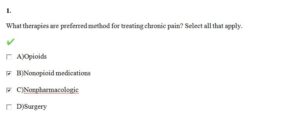1.
What therapies are preferred method for treating chronic pain? Select all that apply.
A)Opioids
B)Nonopioid medications
C)Nonpharmacologic
D)Surgery
2.
Which statement(s) best describe empathy as a strategy in a patient-centered treatment? Select all that apply.
A)Helps patients feel that they aren’t alone in their experience
B)Boosts patient confidence and motivates change
C)Recognizes patient strengths and efforts
D)Helps patients develop sense of trust and feel understood
3.
Karen Lee, a 63-year old woman, has osteoarthritis. What nonpharmacologic treatment should be considered? Select the best answer.
A)Topical non-steroidal anti-inflammatory drugs (NSAIDs)
B)Exercise
C)Intra-articular glucocorticoid injections
D)Acetaminophen
4.
Which of the following statements correctly describe the risks and benefits of nonopioid medications? Select all that apply.
A)Nonopioid medications are associated with certain risks, which includes patients with certain comorbidities
B)Nonopioid medications are not generally associated with development of substance use disorder
C)Risks associated with nonopioid medications are similar to opioids
D)Nonopioid medications can enhance the effectiveness of opioid therapy
5.
Alan Sayed has neuropathic pain. What nonopioid medications should be considered for his treatment? Select all that apply.
A)Tricyclic antidepressants (TCAs)
B)Topical lidocaine
C)Serotonin and norepinephrine reuptake inhibitors (SNRIs)
D)Gabapentin
Solution:

To access the solution click the icon below to purchase at $10